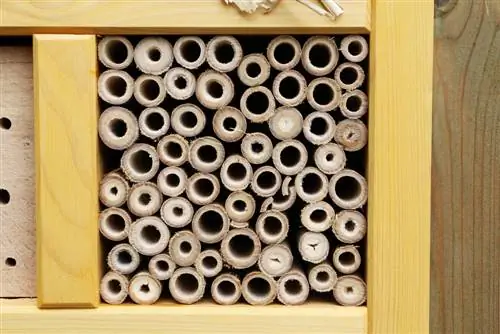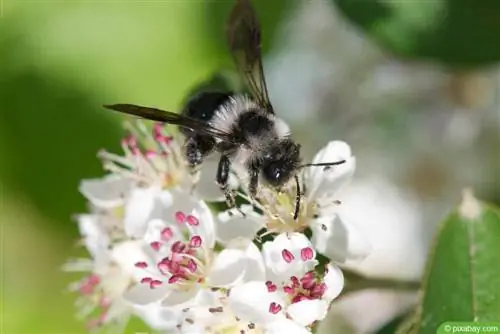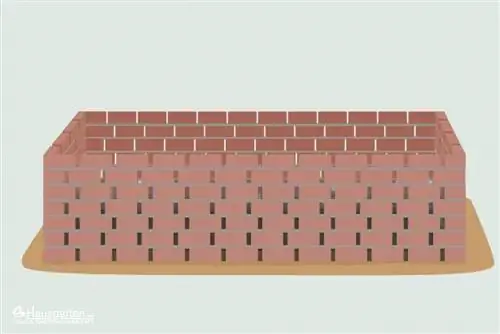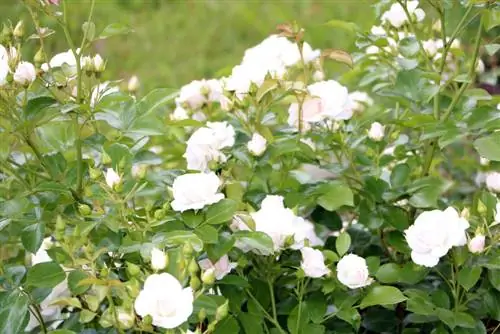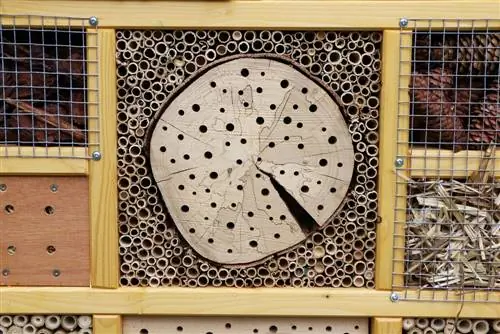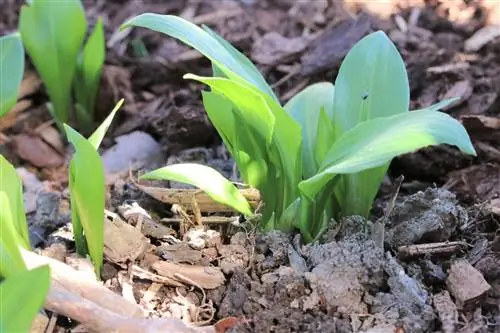- Author admin [email protected].
- Public 2023-12-17 03:39.
- Last modified 2025-01-24 12:45.
Building a wild bee hotel not only contributes to the diversity of animals in your own garden and enables wonderful observations, it also helps the beneficial insects to have a safe living space and thus makes a significant contribution to animal and nature conservation. Unfortunately, many finished hotels are not very suitable for wild bees who live as hermits. Building your own is therefore preferable.
Wild bees
In order to be able to build a suitable wild bee hotel, the lifestyle of these beneficial insects should first be known. Like honey bees, they feed on nectar, so they fly to flowers and pollinate them. An important prerequisite for ensuring that the hotel is accepted is the right environment.
Plants that are also known as bee pastures or beekeeping plants are ideal - i.e. they have an attractive effect on insects. Below:
- Borage
- Buckwheat
- Yellow sweet clover
- Common Robinia
- Crabapple
- Lavender
- Linde
- Raps
- Thyme
- Hyssop
There are also special flower mixtures available in stores that bees like to fly to. Of course, the right planting is only one factor that can make the wild bee hotel a success. In addition, it must also be taken into account that wild bees live solitary lives. They do not live as a colony like honey bees. Instead, they use holes in wood and soil, dry plants and cracks in masonry and bricks to provide themselves and their offspring with appropriate protection. You need enough space and distance from other insect nests.
Tip:
Bluebells do not serve as the main source of food for most bees, but their flowers are used by male bees as a nighttime sleeping place, among other things. They can therefore also contribute to the successful colonization of the wild bee hotel.
Materials
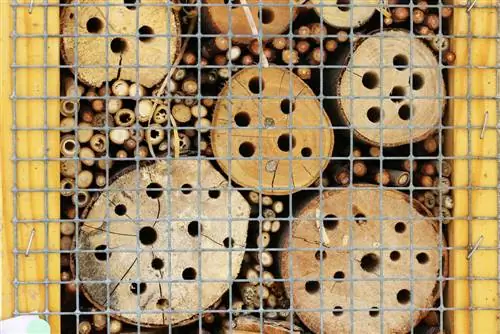
So that the useful insects also move into the wild bee hotel, the material is particularly important. Nature provides clear guidance here. Suitable items include:
- Wood
- Brick
- dried plant shoots
- Clay and sand
Tip:
The combination of different materials ensures that the wild bees find suitable accommodation depending on the species and that several wild bees are also attracted.
Wood
Just lay out a few pieces of wood and bees will move in? Unfortunately, it's not quite that simple. And even though ready-made wild bee hotels or insect hotels are often made of wood, not every one is suitable for this. The choice depends on the following criteria:
- seasoned and dry
- free from cracks
- debarked if possible
- Longitudinal wood
- untreated
- Use hardwoods
For the wild bee hotel, tree slices and trunks at least 30 centimeters long as well as untreated firewood or construction wood are ideal. In order for pieces of wood to serve as individual rooms in the wild bee hotel, they must be drilled. The Nature Conservation Association recommends borehole diameters of three to eight millimeters.
However, they can also be up to one centimeter in size. The distance between the individual holes should be at least two to three centimeters. Drilling is carried out lengthways and, if possible, into the longitudinal wood. This prevents cracks from forming in the wood, as these are avoided by wild bees. Furthermore, drills that are as long as possible should be used, but the wood should not be drilled completely through. The drilling dust must be removed and any rough or splintered drilling edges are sanded smooth.
Brick
Bricks are commercially available in many wild bee hotels, but usually the wrong kind. Hollow and perforated bricks are completely unsuitable and are not used by the bees. If you don't want to miss out on building your own, it's best to use interlocking bricks. No further preparation or processing of these is necessary as they already have holes in the longitudinal direction.
Dried plant shoots
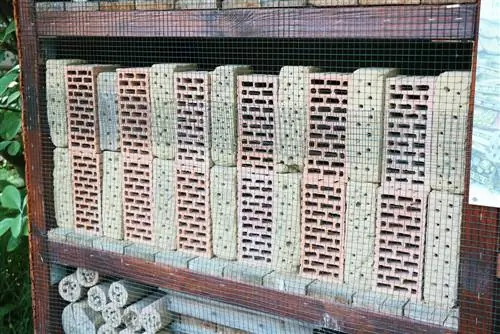
In some wild bee hotels, willow branches or stalks containing pith are used, bundled and aligned horizontally - but many insects or even wild bees do not appear on these. They simply do not correspond to the preferred living spaces of the beneficial insects.
Better suitable are:
- Bamboo
- Reeds
- dry blackberry vines
- mullein stems
These should not be bundled and should also be placed vertically or diagonally. Because wild bees follow the example of nature and neat, tightly bundled and lying stems do not occur in nature.
Clay and sand
Many species of wild bees drill holes in the ground or use existing tunnels as sleeping and nesting places. For this reason, willow branch clay walls are sometimes used in finished wild bee hotels, but unfortunately these are unsuitable in most cases. Dry clay is too hard to allow digging tunnels.
Boxes with a mixture of sand and clay are better. This keeps the material loose and allows passages to be built.
Basic framework
A wild bee hotel traditionally has walls and a roof, a kind of basic structure into which the various materials can be placed. This should meet the following factors:
- overhanging roof
- four-sided frame
- Back wall
- Side lengths of 80 to 100 centimeters if possible
- untreated wood
The frame can of course be built yourself, but it is easier to buy a simple wooden box. A roof can be added to protect against rain and provide light shade. All you need is a simple board that acts as an extension of a side wall and is screwed or nailed on.
Construction instructions
The effort and construction instructions for the wild bee hotel obviously differ depending on which raw materials are used. If you use a finished wooden box, you just have to attach a roof. If you want to build the scaffolding yourself, the following steps are required:
- Four boards as a frame, each connected at the edges with nails, screws or angles.
- Fix the back wall to the frame with nails.
- You can either use a wider side wall as a protruding roof or attach an additional board on the top. This in turn can be screwed or nailed on.
- The wild bee hotel is provided with rooms by providing it with pre-drilled pieces of wood, interlocking bricks, vertically positioned tendrils and stems. Boxes with the described sand-clay mixture can be placed on the floor and other materials can be stacked on top. The only important thing is that the boxes can only be reached through a few holes between wood, brick and dry plant parts.
Location
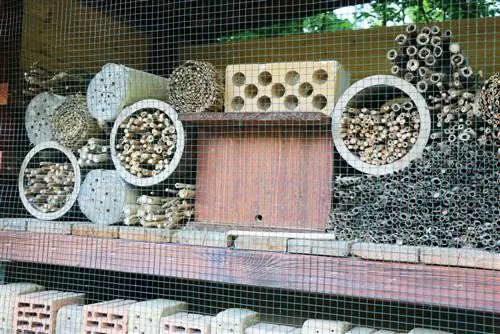
The wild bee hotel can be ready for occupancy, but if it is in the wrong place, there will still be no insects in it. The attachment must be stable so that the wild bee hotel must not wobble or hang in the wind. It is therefore advisable to place it on a stable surface. In addition, the following requirements must be met.
- sunny but not unprotected from the blazing midday sun
- protected from rain and wind
- standing elevated
It is ideal to place the bee shelter on a table near a wall on the balcony or in the garden. Being close to flowering shrubs, perennials and flowers doesn't hurt either. An orientation towards the south with appropriate roofing, southeast or east makes sense.
Protection
A successfully built wild bee hotel should attract the beneficial insects, but is also attractive to their predators. After all, it is a real buffet for birds. To ensure that moving into the hotel does not end fatally for the bees, appropriate protective measures should be taken.
- Make drill holes deep enough, they should be at least eight to ten centimeters
- Insert materials towards the front so as not to offer birds landing opportunities due to protruding elements
Put a blue net with a mesh size of about three centimeters in front of the wild bee hotel; the distance between the net and the hotel should be about 20 centimeters.
The blue net is particularly easy for birds to recognize and avoid as an obstacle. At the same time, it is wide-meshed enough to not pose a danger to birds and other animals that could get caught in it.
Tip:
Wild bee hotels with glass tubes that allow the residents to be observed are commercially available. However, mold can form in these and the offspring of wild bees can be affected by rot due to the lack of ventilation.
Time
It is good to set up the wild bee hotel in winter or early spring, as the newly hatched bees start looking for suitable shelter in the spring. In addition, the hotel should remain outdoors all year round. The larvae take a year to develop into adult wild bees. Once a female has moved in and laid her eggs, the hotel is inhabited all year round.

